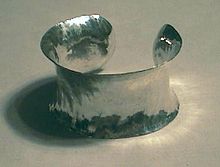bracelet



A bracelet or bangle is a piece of jewelry that is worn on the wrist and encloses it.
The bracelet consists of flexible materials such as chain links made of metal, pearls, shells, precious stones, horn, bones, animal teeth or made of cloth, silk, leather, rubber or plastic straps.
The bangle or bangle , on the other hand, consists initially of hard materials such as limestone , bone , marble , slate , serpentine and clay; later made of metal and is ring- or semi-ring-shaped.
History and meaning of the bracelets
The use of jewelry goes back to the dawn of mankind; Neck and arm jewelry in the form of simple but also multi-link chains is documented as early as the Paleolithic. Since the discovery of the processing possibilities of copper and bronze , these have been processed into rolls, plates, pearls, rings and discs. The use of organic substances such as animal teeth or amber , however, decreased.
Coral bracelets are still handcrafted in Tibet and are extremely popular as jewelry in Europe.
With the discovery of metal processing in the Bronze Age through glass production to the development of plastics , the range of materials used expanded. With the use of valuable materials, the jewelry also became an object of value. The bracelet, worn in the form of silver rings, was at times a means of payment.
The bracelet also served as a protective shield on the hunter's and warrior's wrist and as a protection against sword blows. Among the Celts, male warriors wore silver bracelets as a symbol of their nobility and as an expression of their position of power.
The bracelet, the forwards Armilla ( bangle ), which for Coronation ornat belonged to the German Kaiser.
In Europe, in contrast to antiquity, bracelets were almost exclusively worn by women from the Middle Ages until the advent of the modern wristwatch at the end of the 19th century, depending on the fashion, especially in the Renaissance and 19th century.
Types of bracelets
In addition to the primary importance of bracelets as jewelry, some of them also have a more extensive function, such as watch straps , which make it possible to wear a watch on the wrist and are also made of leather, metal or synthetic. Such bracelets for watches can now also be equipped with additional functions. This allows, among other things, access authorizations, monetary values or personal data to be saved in the bracelet. Thanks to rembordering , the seamless connection of upper and lining leather, leather bracelets now also have a very high level of water resistance.
Athletes wear special sweat armbands made of terry cloth . A relatively new development are so-called sports armbands, which are usually made of neoprene and to which iPods and other MP3 players are attached in such a way that the display can also be viewed during sports, for example jogging .
In the hospital, admitted patients are given a patient wristband that contains information to avoid confusion between the side and the procedure and to correctly assign medical documentation, such as the allocation of medication, mostly automatically using printed barcodes . For newborns, the color of the bracelet (pink or light blue) also provides information about the baby's gender.
In the sports area, for example in the swimming pool, there are plastic wristbands with keys or chips that grant access to certain areas, such as the changing room. Sometimes they even serve as a cashless payment method.
Friendship bracelets are worn by young people and mostly made by themselves . The silicone bracelets made famous by the cyclist Lance Armstrong identify the wearer as a supporter of aid organizations.
Bracelets worn in the homosexual scene, which are supposed to convey information, are usually made of leather. When worn on the left arm, they signal that the wearer is sexually active, when worn on the right arm, that it is passive. (see Hanky Code )
Individual evidence
See also
Web links
- Fashion jewelry à la Stone Age. On: Wissenschaft.de from June 23, 2006
- Celtic replicas made of silver and bronze, including bracelets for men and women
- Bone bracelet unearthed in Troy III
Individual evidence
- ^ Helmut Kahlert , Richard Mühe , Gisbert L. Brunner : Wristwatches: 100 years of development history . Callwey, Munich 1983; 5th, expanded edition, ibid. 1996, ISBN 3-7667-1241-1 , p. 9 f.




